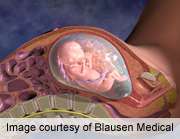(HealthDay)—The introduction of combined first-trimester screening correlated with an increase in chorionic villus sampling (CVS) and a decrease in amniocentesis, while both CVS and amniocentesis decreased with the introduction of noninvasive prenatal testing, according to research published online May 6 in Obstetrics & Gynecology.
Sebastian Larion, from the Eastern Virginia Medical School in Norfolk, and colleagues describe the changes over time in the number and rate of diagnostic testing after introduction of the combined first-trimester screen and noninvasive prenatal testing. Data were considered from three time intervals: before introduction of a combined screen; after introduction of a combined first-trimester screen; and after introduction of noninvasive prenatal testing.
The researchers found that the peak in combined first-trimester screening was in 2009 to 2010, with 1,836 procedures. There was a 48.1 percent decrease after introduction of noninvasive prenatal testing. After introduction of combined first-trimester screening in 2007 to 2008, CVS peaked at 100 procedures, representing an 81.8 percent increase from the pre-combined screen period. During 2012 to 2013, after introduction of noninvasive prenatal testing, there was a 68.6 percent decrease in CVS. There was a decrease in amniocentesis every year of the study period (78.8 percent overall), with a 60.3 percent decrease after combined first-trimester screen and an additional 46.7 percent decrease after noninvasive prenatal testing. Similar trends were seen in analyses per 100 morphologic ultrasonograms.
"With increasing physician and public awareness of the availability of noninvasive prenatal testing, we expect similar trends to be experienced at other institutions," the authors write.
One author disclosed financial ties to Illuminia-Verinata, a manufacturer of prenatal tests.
More information:
Abstract
Full Text (subscription or payment may be required)
Journal information: Obstetrics & Gynecology
Copyright © 2014 HealthDay. All rights reserved.



















